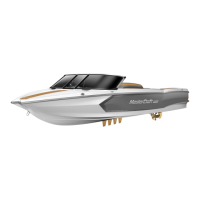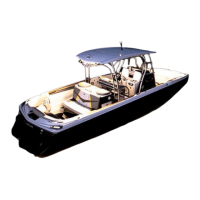avoid this situation, when the voltage level falls to 10.5 volts, the
system will shut off the stereo system and sound an alarm for a
period of two (2) minutes to allow the operator time to turn the
ignition keys ON and start the engines. Doing so will allow the
engine’s alternators to recharge the battery.
Charge dead batteries with a battery charger before attempting
to start the engine. (Some Aviara models offer an optional
battery charger; but never jump-start the battery.) Jump-starting
from another boat or battery is dangerous! Charging a dead battery
from a third party engine will put undue stress on the alternator,
which may cause it to fail.
When charging, batteries generate small amounts of dangerous
hydrogen gas. This gas is highly explosive. Keep all sparks, flames
and smoking well away from the area. Failure to follow instructions
when charging a battery may cause an electrical charge or even an
explosion of the battery, which could cause death or serious injury.
DO NOT IGNORE OR OVERLOOK THIS INSPECTION! REPAIR AS
NECESSARY!
Before Each Use
After Starting the Engines
Check That The Batteries are Fully Charged
As the boat is started, check all gauges, but pay particular
attention to the voltage.
When starting the engines, check that the voltmeter reads
between 12.4 and 14.5 volts. An erratic reading may be a sign
of low voltage. The voltage reading is the best indication of
the status of your batteries, however it is not fool-proof. While
the reading may indicate that the battery is producing current,
if during a previous operation you had reason to suspect a
problem with your batteries, check with an authorized Aviara
dealer’s service department.
Current models are equipped with a low-voltage battery alarm.
In the event that the stereo or other electrical equipment has
been functioning when the boat engine is OFF, the voltage drain
on the batteries may result in difficulties restarting the boat. To

